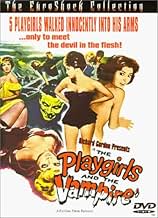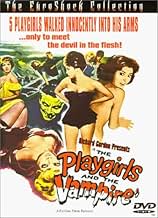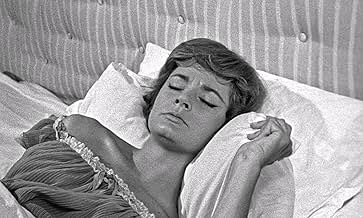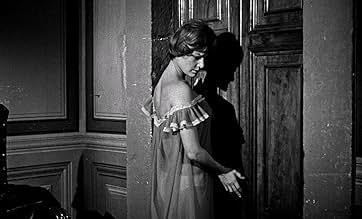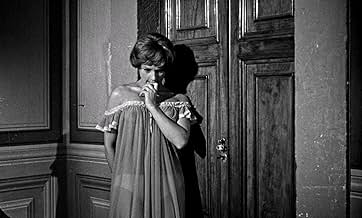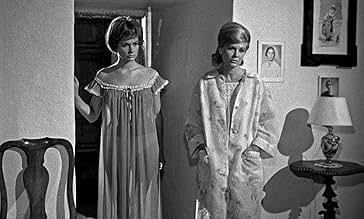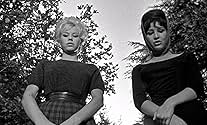IMDb RATING
5.1/10
682
YOUR RATING
Five beautiful showgirls are trapped by a storm and find refuge in a creepy old castle. The owner of the castle, a strange nobleman, has a secret laboratory in the basement and has his own p... Read allFive beautiful showgirls are trapped by a storm and find refuge in a creepy old castle. The owner of the castle, a strange nobleman, has a secret laboratory in the basement and has his own plans for the girls.Five beautiful showgirls are trapped by a storm and find refuge in a creepy old castle. The owner of the castle, a strange nobleman, has a secret laboratory in the basement and has his own plans for the girls.
Featured reviews
This film was of interest to me because it was the first horror film that I ever saw. At the time, I was attending college in Newcastle, and one day on leaving college, I passed the Essoldo, Westgate Road which was showing this film. On a whim, I decided to go in and see it. With the X certificate, I was expecting that my blood would be well and truly curdled, but it did not turn out that way. In fact, I found it rather dull. Looking at the DVD today, it all seems rather tame. Perhaps it's interest lies in that for cinemas like the Essoldo with little access to the major new releases, this was the sort of thing that they had to show.
You are lost on a lonely Italian road. A storm is coming up. There is no motel around. You spot a castle. Stay away, you dolt! Sleep in the car. Do not enter the creepy castle.
Alas, our group does not heed the warning and end up in a castle. The owner, Count Gabor Kernassy (Walter Brandi), tries to shoo them away, but there seems to be a connection with one named Vera (Lila Rocco). She even knows where the smokes are kept, even though she has never been there.
Despite warnings, one of the girls (Maria Giovannini) goes wandering and surprise, she's found dead the next day. I guess the story would have ended too soon if they all obeyed the Count.
There was not a lot of blood in this early Italian classic, and there was only a brief flash of nudity. The girls did, however, do a lot of running around in their see-through nighties. I always though castles were cold and damp. I guess this one had central heat.
For true vampire aficionados only.
Alas, our group does not heed the warning and end up in a castle. The owner, Count Gabor Kernassy (Walter Brandi), tries to shoo them away, but there seems to be a connection with one named Vera (Lila Rocco). She even knows where the smokes are kept, even though she has never been there.
Despite warnings, one of the girls (Maria Giovannini) goes wandering and surprise, she's found dead the next day. I guess the story would have ended too soon if they all obeyed the Count.
There was not a lot of blood in this early Italian classic, and there was only a brief flash of nudity. The girls did, however, do a lot of running around in their see-through nighties. I always though castles were cold and damp. I guess this one had central heat.
For true vampire aficionados only.
Notable actors: Walter Brandi! Walter Brandi again!
More vampire madness from Italy as five exotic dancers, one grumpy manager, and one level headed musician end up at the creepy castle of Walter Brandi. We've already been alerted that something's amiss in this place with the atmospheric opening credits, but when dancer Vera seems to recognise the place, including where the cigarettes are kept (?), the mystery deepens...if you haven't watched a vampire film, ever. Walter Brandi and his minions tell the group to beat it but when he sets his sights on Vera, he quickly changes his tune, instead letting them stay on the condition that everyone stays in their rooms at night and definitely do not go wandering around the place at night. Of course, the dumbest of the girls, Katya (who is completely obsessed with her legs!), goes out to find the shower and ends up being attacked by someone, ending up dead outside the next day.
Everyone of course is very upset so they decide they best thing to do is to perform a bit of a dance routine! Better still, one of the girls decides to turn it into a full on striptease instead. I know the girls are supposed to be upset, but the crapness of their dancing is a sight to behold. Except the striptease which is quite good unless you do the mental arithmetic and figure out that the woman you are looking at in well into her seventies, you perv!
Of course someone digs up Katya's body and before you know it she's prancing about the about in the nude trying to put the bite on various people (and at this point the film steals the 'earliest boobs' crown from 1964's Castle of Blood. The plot thickens as Walter Brandi seems to be hiding something but if he's a vampire, why is walking about during the day? Walter and Vera fall in love (do I even need to mention that she's the reincarnation of a distant relative?) and there's a vampire or two to be taken out before the film ends.
(Spoilers next, if you're mental and didn't figure out what's going on)
You see, Walter's ancestor is a vampire and living in the basement, and he also recognised Vera. However, he killed Katya by mistake because she was wearing Vera's coat, but the funniest thing about this is Katya's incessant, instant nagging of vampire Walter! She just won't stop henpecking him, which leads to a pretty bloody staking. Also, when Walter himself gets impaled on the bizarre family crest, the results are rather bizarre.
While not as stupid/enjoyable as The Vampire of the Opera, this one tries to give it a run for its money.
More vampire madness from Italy as five exotic dancers, one grumpy manager, and one level headed musician end up at the creepy castle of Walter Brandi. We've already been alerted that something's amiss in this place with the atmospheric opening credits, but when dancer Vera seems to recognise the place, including where the cigarettes are kept (?), the mystery deepens...if you haven't watched a vampire film, ever. Walter Brandi and his minions tell the group to beat it but when he sets his sights on Vera, he quickly changes his tune, instead letting them stay on the condition that everyone stays in their rooms at night and definitely do not go wandering around the place at night. Of course, the dumbest of the girls, Katya (who is completely obsessed with her legs!), goes out to find the shower and ends up being attacked by someone, ending up dead outside the next day.
Everyone of course is very upset so they decide they best thing to do is to perform a bit of a dance routine! Better still, one of the girls decides to turn it into a full on striptease instead. I know the girls are supposed to be upset, but the crapness of their dancing is a sight to behold. Except the striptease which is quite good unless you do the mental arithmetic and figure out that the woman you are looking at in well into her seventies, you perv!
Of course someone digs up Katya's body and before you know it she's prancing about the about in the nude trying to put the bite on various people (and at this point the film steals the 'earliest boobs' crown from 1964's Castle of Blood. The plot thickens as Walter Brandi seems to be hiding something but if he's a vampire, why is walking about during the day? Walter and Vera fall in love (do I even need to mention that she's the reincarnation of a distant relative?) and there's a vampire or two to be taken out before the film ends.
(Spoilers next, if you're mental and didn't figure out what's going on)
You see, Walter's ancestor is a vampire and living in the basement, and he also recognised Vera. However, he killed Katya by mistake because she was wearing Vera's coat, but the funniest thing about this is Katya's incessant, instant nagging of vampire Walter! She just won't stop henpecking him, which leads to a pretty bloody staking. Also, when Walter himself gets impaled on the bizarre family crest, the results are rather bizarre.
While not as stupid/enjoyable as The Vampire of the Opera, this one tries to give it a run for its money.
Ragnoli's film focuses on the travails of a group of five dance hall girls and their manager who, after defaulting on a hotel bill, find themselves bumping through unfamiliar countryside at night looking for late accommodation. Ignoring the warnings of a local, they continue along a side road to the castle of a mysterious Count Kernassy (Walter Brandi), where one of the girls, Vera experiences strong feelings of déjà vu. At first treated with coldness, it soon appears that the beautiful-yet-mopey Vera bears a startling resemblance to one of Count Kernassy's ancestors, Margherita. Ominously, the Count has an infatuation with this long-dead beauty. As sudden storms wash out bridges behind them, the troupe are obliged to spend more than one night at the castle and, despite warnings, venture out of the their rooms at night...
A minor camp item with some historical interest today, The Playgirls And The Vampire first saw light of day on the continent as L'ultima preda del vampiro (trans: The Vampire's Final Prey), an Italian attempt to capitalise on the vogue for the contemporary Hammer product with a suitably spiced-up Euro version. Adding lashings of female titillation in a way which was unthinkable to the Anglo Saxon market (the film includes a brief topless shot), director Piero Ragnoli made up a package which was both more lascivious than that produced by the studio at Bray, and one to which critical opinion has been less kind. Predictably, the heady cocktail was a commercial success at the time, and some commentators have since seen the results as anticipating the sexy vampire cinema of Jean Rollin a few years later, although the sheen of erotic sophistication brought by the French auteur is conspicuously missing here. American producer Richard Gordon, sensing money from the exploitation market, promptly picked up the English language rights to the original film, did a rush-dubbing job and re-titled it with an eye on maximum marquee appeal. (He also prepared a cut print for those areas in which censorship was more squeamish, under the title of Curse Of The Vampire - a version that by all accounts approached the incoherent).
While the beginning of this version of the film, which features a long tracking shot from a dungeon window to a stone sarcophagus and an emerging, spidery hand, momentarily recalls some of the splendours of such films as Bava's Mask Of The Demon (aka: La Maschera del demonio, 1960), such atmospherics are rarely repeated. The most effective moment occurs during the big burial scene later, where Aldo Greci's camera performs a 360-degree pan around the faces of the mourners from a low angle. Here the combination of a daring, continuous shot, allied with the distortions of a wide-angle lens produces the sense of dread a film like this so badly needs. Elsewhere the cinematography is more careless, with at least one scene suffering from a distracting focus problem, and the sparse interiors of the Count's castle being lit without subtlety. Unfortunately, the plot hardly distracts one from such shortcomings. Containing more holes than a ghoul's winding sheet, in execution it only emphases that for the most part Ragnoli's technical competence is mediocre. Given the electric possibilities which exist when sex and horror are combined, his film rarely aspires to the erotic, even though the glamorous playgirls are frequently to be seen wandering through chilly grounds and corridors, clad in nothing but their nighties.
What makes the film enjoyable is the passing campness of it all, the ineptness of the characters and the ludicrousness of some of the dialogue. The girls form part of a truly terrible dance troupe: when, after a tragedy, they gather to lose themselves in a rehearsal ("the girls have been very upset, and this is the only way to make them stop worrying about it" we are assured) and one performs a striptease, their lack of professionalism and poise in ensemble is laughable. Their manager, Lucas, (Alfredo Rizzo) is a crabby, cynical showman who is at least a more believable stereotype than the dull vampire fodder he escorts. In one of the more amusing moments of the film, we see him snuggling down in his room with a girlie magazine before being confronted by a nude, newly dead girl. Here his mugging is entertaining and the often self-conscious dialogue, which is a feature of the film, doesn't intrude. Elsewhere the non-sequiturs can be amazing ("I just don't understand it"/ "What don't you understand?"/ "Nothing, nothing at all" is one worthy of Ed Wood). As various mysterious events unfold, such conversations contribute to an atmosphere that can be just as bewildering to the audience as to the principals. Supporting characters, such as the groundskeeper, the limping Zoltan (probably Antoine Nicos), and the housekeeper (Marisa Quattrini) remain woefully undeveloped which given the nature of the genre, where every servant is a satanic stooge it seems, is surprising. One especially regrets the waste of the housekeeper. A demonic Mrs Danvers would have been a useful bonus in taking up some of the dramatic slack.
As "one of the first horror films from any country to mix Gothic horror and explicit eroticism," the film is a slight genre landmark. Perhaps a director with a greater sense of visual style would have made more of the opportunity, but the result is still watchable, if a little slow. For those who enjoy continental horror from this time - the start of a classic production period, which until recently has been hard to see - this is worth seeking out, if not essential viewing.
A minor camp item with some historical interest today, The Playgirls And The Vampire first saw light of day on the continent as L'ultima preda del vampiro (trans: The Vampire's Final Prey), an Italian attempt to capitalise on the vogue for the contemporary Hammer product with a suitably spiced-up Euro version. Adding lashings of female titillation in a way which was unthinkable to the Anglo Saxon market (the film includes a brief topless shot), director Piero Ragnoli made up a package which was both more lascivious than that produced by the studio at Bray, and one to which critical opinion has been less kind. Predictably, the heady cocktail was a commercial success at the time, and some commentators have since seen the results as anticipating the sexy vampire cinema of Jean Rollin a few years later, although the sheen of erotic sophistication brought by the French auteur is conspicuously missing here. American producer Richard Gordon, sensing money from the exploitation market, promptly picked up the English language rights to the original film, did a rush-dubbing job and re-titled it with an eye on maximum marquee appeal. (He also prepared a cut print for those areas in which censorship was more squeamish, under the title of Curse Of The Vampire - a version that by all accounts approached the incoherent).
While the beginning of this version of the film, which features a long tracking shot from a dungeon window to a stone sarcophagus and an emerging, spidery hand, momentarily recalls some of the splendours of such films as Bava's Mask Of The Demon (aka: La Maschera del demonio, 1960), such atmospherics are rarely repeated. The most effective moment occurs during the big burial scene later, where Aldo Greci's camera performs a 360-degree pan around the faces of the mourners from a low angle. Here the combination of a daring, continuous shot, allied with the distortions of a wide-angle lens produces the sense of dread a film like this so badly needs. Elsewhere the cinematography is more careless, with at least one scene suffering from a distracting focus problem, and the sparse interiors of the Count's castle being lit without subtlety. Unfortunately, the plot hardly distracts one from such shortcomings. Containing more holes than a ghoul's winding sheet, in execution it only emphases that for the most part Ragnoli's technical competence is mediocre. Given the electric possibilities which exist when sex and horror are combined, his film rarely aspires to the erotic, even though the glamorous playgirls are frequently to be seen wandering through chilly grounds and corridors, clad in nothing but their nighties.
What makes the film enjoyable is the passing campness of it all, the ineptness of the characters and the ludicrousness of some of the dialogue. The girls form part of a truly terrible dance troupe: when, after a tragedy, they gather to lose themselves in a rehearsal ("the girls have been very upset, and this is the only way to make them stop worrying about it" we are assured) and one performs a striptease, their lack of professionalism and poise in ensemble is laughable. Their manager, Lucas, (Alfredo Rizzo) is a crabby, cynical showman who is at least a more believable stereotype than the dull vampire fodder he escorts. In one of the more amusing moments of the film, we see him snuggling down in his room with a girlie magazine before being confronted by a nude, newly dead girl. Here his mugging is entertaining and the often self-conscious dialogue, which is a feature of the film, doesn't intrude. Elsewhere the non-sequiturs can be amazing ("I just don't understand it"/ "What don't you understand?"/ "Nothing, nothing at all" is one worthy of Ed Wood). As various mysterious events unfold, such conversations contribute to an atmosphere that can be just as bewildering to the audience as to the principals. Supporting characters, such as the groundskeeper, the limping Zoltan (probably Antoine Nicos), and the housekeeper (Marisa Quattrini) remain woefully undeveloped which given the nature of the genre, where every servant is a satanic stooge it seems, is surprising. One especially regrets the waste of the housekeeper. A demonic Mrs Danvers would have been a useful bonus in taking up some of the dramatic slack.
As "one of the first horror films from any country to mix Gothic horror and explicit eroticism," the film is a slight genre landmark. Perhaps a director with a greater sense of visual style would have made more of the opportunity, but the result is still watchable, if a little slow. For those who enjoy continental horror from this time - the start of a classic production period, which until recently has been hard to see - this is worth seeking out, if not essential viewing.
The Playgirls and the Vampire is the English-language version of Piero Regnoli's L'ultima preda del vampiro, released in the US by enterprising producer and distributor Richard Gordon.
The film sees a troupe of exotic dancers, their piano player Frank (Leonardo Botta) and manager Lucas (Alfredo Rizzo) seeking refuge at a remote castle after they are forced to take a detour in their minibus. The owner of the castle, Count Gabor Kernassy (Walter Brandi), reluctantly allows the visitors to stay but neglects to tell them about the vampire that stalks the place at night...
The plot for this film is pedestrian (it's very similar to the equally desperate The Vampire and the Ballerina, released earlier the same year) and the script is uninspired, the film relying on the allure of its scantily clad women to retain the viewer's interest. The ladies are certainly attractive, but even with plenty of 'cheesecake' (and a brief glimpse of nudity), The Playgirls and the Vampire is a colossal bore, director Regnoli handling matters with zero sense of style or finesse.
The most entertaining things about the film are the hilarious dance rehearsal, in which each girl does their own thing, all of them gyrating awkwardly out of time to the music, and the terrible special effects used to show the vampire disintegrating when he is impaled. But as funny as these scenes are, they're not nearly enough to make up for the rest of this clumsy Eurohorror, which is as dull and dreary as the castle in which it is set.
The film sees a troupe of exotic dancers, their piano player Frank (Leonardo Botta) and manager Lucas (Alfredo Rizzo) seeking refuge at a remote castle after they are forced to take a detour in their minibus. The owner of the castle, Count Gabor Kernassy (Walter Brandi), reluctantly allows the visitors to stay but neglects to tell them about the vampire that stalks the place at night...
The plot for this film is pedestrian (it's very similar to the equally desperate The Vampire and the Ballerina, released earlier the same year) and the script is uninspired, the film relying on the allure of its scantily clad women to retain the viewer's interest. The ladies are certainly attractive, but even with plenty of 'cheesecake' (and a brief glimpse of nudity), The Playgirls and the Vampire is a colossal bore, director Regnoli handling matters with zero sense of style or finesse.
The most entertaining things about the film are the hilarious dance rehearsal, in which each girl does their own thing, all of them gyrating awkwardly out of time to the music, and the terrible special effects used to show the vampire disintegrating when he is impaled. But as funny as these scenes are, they're not nearly enough to make up for the rest of this clumsy Eurohorror, which is as dull and dreary as the castle in which it is set.
Did you know
- TriviaMaria Giovannini's Katia is the first depiction of a nude vampire on screen; years before erotic/horror directors Jean Rollin and Jess Franco, and Hammer Studios made seductive naked women with fangs a staple of the genre.
- ConnectionsEdited into FrightMare Theater: Playgirls and the Vampire (2017)
- How long is The Playgirls and the Vampire?Powered by Alexa
Details
- Release date
- Country of origin
- Language
- Also known as
- The Playgirls and the Vampire
- Filming locations
- Palazzo Borghese, Artena, Rome, Lazio, Italy(interiors)
- Production company
- See more company credits at IMDbPro
- Runtime1 hour 23 minutes
- Color
- Sound mix
- Aspect ratio
- 1.37 : 1
Contribute to this page
Suggest an edit or add missing content


